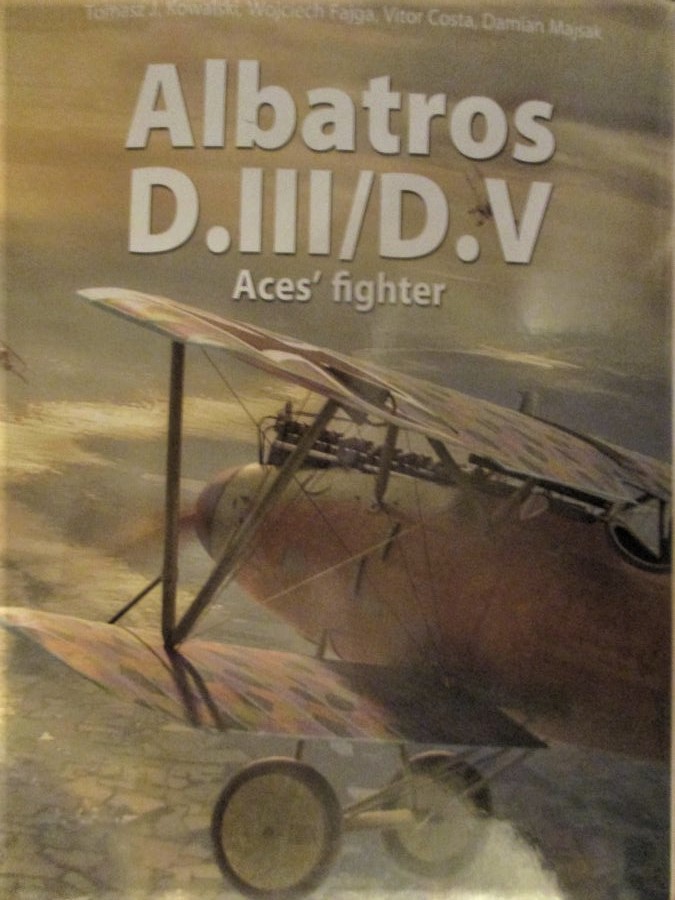Albatros D.III/D.V, Aces’ Fighter
History
Nicely written on both English and Polish, this book provides the history of the German Albatros D.I through D.Va fighters in both German and Polish service. The Albatros was the replacement for the earlier Fokker Eindekker series, beginning service in mid 1916 until being replaced by the Fokker D.VII in 1917 and 1918. Most of the famous aces flew the type, including von Richtofen and Bolcke, and they operated the type successfully on the Western Front until outclassed by the British S.E.5’s and Sopwith Camels, and the French SPADs. After replacement, they were used in less important theatres of operation and as trainers. Many survived the war, and quite a few were spirited away to Poland, where they became one of the important types in the fledgling Polish Military Aviation, which used them effectively against the Russian Communists who were trying to expand into Polish territory after the end of World War I. The Poles also acquired many from German stocks stored in Poland. Most were overhauled by the Poles and used until they were replaced by indigenous Polish aircraft as the national industry began developing types of its own in the early twenties.
The Book
The book is made up of four main chapters. The first outlines the technological development of the Albatros D. series, giving a complete account of prototype development and service history, along with details on construction and colors used. The text is provided in both languages, with English on the left column and Polish on the right. Many archival photos are included, most of which I haven’t seen before. Two pages of what appear to be original Albatros line drawings provide a 3 view of a D.III and some detail drawings of parts of the airplane, including wing strut and bracing arrangements and the landing gear.
The following three chapters deal with the building of three models of the plane. Chapter 2, by Vitor Costa, describes the building of a 1/48 scale Eduard Albatros D.III kit. This latter section of the book is probably most useful for a modeler, as the authors describe the interior details of the model, and the series of color photos is most useful, providing enough information to a serious modeler to super detail a model of the Albatros in any scale. Photos of the model in all stages of construction are provided, and photos of the finished model are most impressive.
Chapter 3, by Wojciech Fajga, provides the same treatment of the construction of a Wingnut Wings 1/32 scale kit of an Albatros D.V. Obviously, the detail is greater in the 1/32 kit, and the photos show the model in all stages of construction, allowing the modeler to see the arrangement of the structure as well as the colors involved. Even though these kits are highly detailed, these modelers, who must have had an immense amount of time on their hands, obviously did a lot of scratch building to develop the detail they included in the kits. These models are infinitely better than most of the ones I saw in last summer’s IPMS Convention in Phoenix.
Chapter 4, by Damian Majsak, covers another German Albatros, this time a D.Va in 1/32 scale by Wingnut Wings. His coverage includes a historical account of the pilot of the aircraft being depicted, Walter Boning, along with a list of his 33 victories over enemy aircraft. One feature of these articles of the larger scale aircraft is the inclusion of photos of some of the jigs and tools used to assemble and line up the airframes. This information will be of intense value to a modeler who wants to build this type of model. These chapters provide much useful information on building any type of airplane from this era.
The last section of the book provides some color profile drawings of Albatros D.I through D.Va aircraft in German and Polish markings, and this information would be useful for modelers in any scale. Drawings are provided for 11 different aircraft, and they are excellently done.
Recommendations
The only negative thing I can say about this book is that it did not include a series of line three view profiles of all of the different versions of the Albatros, especially the W.4 Seaplane and the Dr.1 Triplane. These are shown in photos, but there is not enough information provided in the book to build these variants from existing kits. In addition, I would like to have seen some mention of other kits available of these aircraft, as there are, according to the Burns Guide, approximately 40 different issues of Albatros fighters in 1/48, 1/72 and 1/144 scale, and some of them are probably still available.
On the other hand, if you are building an Albatros in any scale, this book is certainly worth getting, as the detail information provided is more than worth the price of the book. If you have any interest in this fascinating time period in the history of aviation, don’t miss out on this one. Get a copy while you can.
Highly recommended.
Thanks to Phil Peterson and Kagero for the review sample.












Comments
Add new comment
This site is protected by reCAPTCHA and the Google Privacy Policy and Terms of Service apply.
Similar Reviews